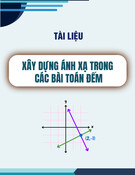
Research Article
Theme: Revisiting IVIVC (In Vitro-In Vivo Correlation)
Guest Editors: Amin Rostami Hodjegan and Marilyn N. Martinez
Evaluating In Vivo-In Vitro Correlation Using a Bayesian Approach
Junshan Qiu,
1,3
Marilyn Martinez,
2
and Ram Tiwari
1
Received 21 November 2015; accepted 25 January 2016; published online 19 February 2016
Abstract. A Bayesian approach with frequentist validity has been developed to support inferences
derived from a BLevel A^in vivo-in vitro correlation (IVIVC). Irrespective of whether the in vivo data
reflect in vivo dissolution or absorption, the IVIVC is typically assessed using a linear regression model.
Confidence intervals are generally used to describe the uncertainty around the model. While the
confidence intervals can describe population-level variability, it does not address the individual-level
variability. Thus, there remains an inability to define a range of individual-level drug concentration-time
profiles across a population based upon the BLevel A^predictions. This individual-level prediction is
distinct from what can be accomplished by a traditional linear regression approach where the focus of the
statistical assessment is at a marginal rather than an individual level. The objective of this study is to
develop a hierarchical Bayesian method for evaluation of IVIVC, incorporating both the individual- and
population-level variability, and to use this method to derive Bayesian tolerance intervals with matching
priors that have frequentist validity in evaluating an IVIVC. In so doing, we can now generate population
profiles that incorporate not only variability in subject pharmacokinetics but also the variability in the in
vivo product performance.
KEY WORDS: IVIVC; MCMC; probability matching prior; tolerance intervals; Weibull distribution.
INTRODUCTION
The initial determinant of the systemic (circulatory
system) exposure resulting from the administration of any
non-intravenous dosage form is its in vivo drug release
characteristics. The second critical step involves the processes
influencing the movement of the drug into the systemic
circulation. Since it is not feasible to run in vivo studies on
every possible formulation, in vitro drug release methods are
developed as surrogates. Optimally, a set of in vitro dissolu-
tion test conditions is established such that it can be used to
predict, at some level, the in vivo drug release that will be
achieved for a particular formulation. This raises the question
of how to assess the in vivo predictive capability of the in vitro
method and the extent to which such data can be used to
predict the in vivo performance of a Bnew^formulation. To
this end, much work has been published on methods by which
an investigator can establish a correlation between in vivo
drug release (or absorption) and in vitro dissolution.
An in vivo/in vitro correlation (IVIVC) is a mathematical
description of the relationship between in vitro drug release
and either in vivo drug release (dissolution) or absorption.
The IVIVC can be defined in a variety of ways, each
presenting with their own unique strengths and challenges.
1. One-stage approaches: For methods employing this
approach, the in vitro dissolution and the estimation of
the in vivo dissolution (or absorption) are linked
within a single step. These methods reflect an attempt
to address some of the statistical limitation and
presumptive mathematical instabilities associated with
deconvolution-based methods (1) and generally ex-
press the in vitro dissolution profiles and the in vivo
plasma concentration vs time profiles in terms of
nonlinear mixed-effect models. Examples include:
(a) Convolution approach: While this typically
involves analysis of the data in two steps, it does
not rely upon a separate deconvolution procedure
(2,3). Hence, it is considered a Bone-stage^
approach. In the first step, a model is fitted to the
unit impulse response (UIR) data for each subject,
and individual pharmacokinetic parameter esti-
mates are obtained. The second stage involves
This article reflects the views of the author and should not be
construed to represent FDA’s views or policies.
1
Office of Biostatistics, Center for Drug Evaluation and Research,
Food and Drug Administration, Silver Spring, Maryland, USA.
2
Office of New Animal Drug Evaluation, Center for Veterinary
Medicine, Food and Drug Administration, Rockville, Maryland,
USA.
3
To whom correspondence should be addressed. (e-mail: junshan.-
qiu@fda.hhs.gov; )
The AAPS Journal, Vol. 18, No. 3, May 2016 ( #2016)
DOI: 10.1208/s12248-016-9880-7
619 1550-7416/16/0300-0619/0 #2016 American Association of Pharmaceutical Scientists

modeling the in vivo drug concentration-time
profiles and the fraction dissolved in vitro for each
formulation in a single step. This procedure allows
for the incorporation of random effects into the
IVIVC estimation.
(b) One-step approach: In this case, neither decon-
volution nor convolution is incorporated into the
IVIVC. Accordingly, this method addresses in vivo
predictions from a very different perspective: using
the IVIVC generated within a single step in the
absence of a UIR to predict the in vivo profiles
associated with the in vitro data generated with a
new formulation (i.e., the plasma concentration vs
time profile is expressed in terms of the percent
dissolved in vitro dissolution rather than as a
function of time). Examples include the use of
integral transformations (4) and Bayesian methods
that allow for the incorporation of within- and
between- subject errors and avoid the need for a
normality assumption (5).
(c) Stochastic deconvolution: We include this pri-
marily for informational purposes as it typically
serves as a method for obtaining an initial decon-
volution estimate. Typically, this would be most
relevant when utilizing a one-stage approach, serv-
ing as a mechanism for providing insights into link
functions (fraction dissolved in vitro vs fraction
dissolved in vivo) that may be appropriate starting
points when applying the one-stage approach.
Although stochastic deconvolution is optimal when
a UIR is available, this can be obviated by an
identifiable pharmacokinetic model and a descrip-
tion of the elimination phase obtained from the
dosage form in question. The in vivo event is
treated as a random variable that can be described
using a nonlinear mixed-effect model (6). A
strength of this method is that it can be applied to
drugs that exhibit Michaelis-Menton kinetics and
biliary recycling (i.e., in situations where an as-
sumption of a time-invariant system may be violat-
ed). A weakness is that it typically necessitates a
dense dataset and an aprioridescription of the
drug’s pharmacokinetics.
(d) Bayesian analysis: This method also addresses
the in vivo events as stochastic processes that can be
examined using mixed-effect models. Assuming that
oral drug absorption is dissolution-rate limited,
priors and observed data are combined to generate
in vivo predictions of interest in a one-stage for a
formulation series. Posterior parameter estimates are
generated in the absence of a UIR (similar to that of
the method by Kakhi and Chttendon, 2013). The link
between observed in vivo blood level profiles and in
vitro dissolution is obtained by substituting the
apparent absorption rate constant with the in vitro
dissolution rate constant. A time-scaling factor is
applied to account for in vivo/in vitro differences. In
so doing, the plasma profiles are predicted directly
on the basis of the in vitro dissolution data and the
IVIVC model parameters (7).
II. Two-stage approaches: The in vivo dissolution or
absorption is modeled first, followed by a second step
whereby the resulting in vivo predictions are linked to the
in vitro dissolution data generated for each of the formula-
tions in question. A UIR provides the backbone upon which
plasma concentration vs time profiles are used to determine
the parameters of interest (e.g.,in vivo dissolution or in vivo
absorption). These deconvolved values are subsequently
linked to the in vitro dissolution data, generally via a linear
or nonlinear regression. Several types of deconvolution
approaches are available including:
1. Model-dependent: these methods rely upon the use of
mass balance considerations across pharmacokinetic
compartments. A one- (8) or two- (9) compartment
pharmacokinetic model is used to deconvolve the
absorption rate of a drug from a given dosage form
over time.
2. Numerical deconvolution: a variety of mathematical
numerical deconvolution algorithms are available,
(e.g., see reviews by 10,11). First introduced in 1978
(12), linear systems theory is applied to obtain an
input function based upon a minimization of the sums
of squared residuals (estimated vs observed
responses) to describe drug input rate. A strength of
the numerical approach is that it can proceed with
minimal mechanistic assumptions.
3. Mechanistic models: In silico models are used to
describe the in vivo dissolution or absorption of a
drug from a dosage form (13,14). A UIR provides the
information upon which subject-specific model physi-
ological and pharmacokinetic attributes (system be-
havior) are defined. Using this information, the
characteristics of the in vivo drug dissolution and/or
absorption can be estimated. A range of in silico
platforms exists, with the corresponding models vary-
ing in terms of system complexity, optimization
algorithms, and the numerical methods used for
defining the in vivo performance of a given
formulation.
Depending upon the timeframe associated with the in
vitro and in vitro data, time scaling may be necessary. This
scaling provides a mechanism by which time-dependent
functions are transformed such that they can be expressed
on the same scale and back-transformation applied as
appropriate (15). Time scaling can be applied, irrespective
of method employed.
Arguments both for and against each of these various
approaches have been expressed, but such a debate is
outside the objectives of the current manuscript. However,
what is relevant to the current paper is that our proposed
use of a Bayesian hierarchal model for establishing the
IVIVC can be applied to any of the aforementioned
approaches for generating an IVIVC. In particular, the
focus of the Bayesian hierarchical approach is its applica-
tion to the BLevel A^correlation. Per the FDA Guidance
for Extended Release Dosage Forms (16), the primary
goal of a BLevel A^IVIVC is to predict the entire in vivo
620 Qiu et al.

absorption or plasma drug concentration time course from
the in vitro data resulting from the administration of drugs
containing formulation modifications, given that the meth-
od for in vitro assessment of drug release remains
appropriate. The prediction is based on the one-to-one
Blink^between the in vivo dissolution or absorption
fraction, A(t), and the in vitro dissolution fraction D(t)
for a formulation at each sampling time point, t. The
Blink^can be interpreted as a function, g, which relates
D(t) to A(t), by A(t) = g(D(t)). To make a valid predic-
tion of the in vivo dissolution or absorption fraction for a
new formulation, A*(t), the relationship between the
A*(t) and the in vitro dissolution fraction, D*(t), should
be the same as the relationship between A(t) and D(t). In
general, this is assumed to be true. Traditionally, mean in
vivo dissolution or absorption fractions and mean in vitro
dissolution fractions have been used to establish IVIVC
via a simple linear regression. Separate tests on whether
the slope is 1 and the intercept is 0 were performed.
These tests are based on the assumption that in vitro
dissolution mirrors in vivo dissolution (absorption) exactly.
However, this assumption may not be valid for certain
formulations. In addition, we should not ignore the fact
that the fraction of the drug dissolved (absorbed) in vivo
used in the modeling is not directly observable.
For the purpose of the current discussion, the IVIVC is
considered from the perspective of a two-stage approach. In
general, the development of an IVIVC involves complex
deconvolution calculations for the in vivo data with intro-
duction of additional variation and errors while the variation
among repeated assessment of the in vitro dissolution data is
relatively small. In this regard, we elected to ignore the
variability among the in vitro repeated measurements. The
reliability of the deconvolution is markedly influenced by
the amount of in vivo data such as the number of subjects
involved in the study, the number of formulations evaluated,
and the blood sampling schedule (17), the model selection
and fit, the magnitude of the within- and between-
individual variability in in vivo product performance, and
analytical errors. These measurement errors, along with
sampling variability and biases introduced by model-based
analyses affect the validity of the IVIVC. Incorporating the
measurement errors, all sources of variability and correla-
tions among the repeated measurements in establishing
IVIVC (particularly at BLevel A^) has been studied using
the Hotelling’sT
2
test (18) and the mixed-effect analysis by
Dune et al. (19). However, these two methods cannot
uniformly control the type I error rate due to either
deviation from assumptions or misspecification of covariance
structures. O’Hara et al. (20) transformed both dissolution
and absorption fractions, used a link function, and incorpo-
rated between-subject and between-formulation variability
as random effects in a generalized linear model. The link
functions used include the logit, the log-log, and the
complementary log-log forms. Gould et al. (5) proposed a
general framework for incorporating various kinds of errors
that affect IVIVC relationships in a Bayesian paradigm
featured by flexibility in the choice of models and underly-
ing distributions, and the practical way of computation. Note
that the convolution and deconvolution procedures were not
discussed in this paper.
Since the in vivo fraction of the drug dissolved/
absorbed is not observable directly and includes
deconvolution-related variation, there is a need to report
the estimated fraction of the drug dissolved (absorbed) in
vivo with quantified uncertainty such as tolerance inter-
vals. Specifically, use of a tolerance interval approach
enables the investigator to make inferences on a specified
proportion of the population with some level of confi-
dence. Currently available two-stage approaches for
correlating the in vivo and in vitro information are
dependent on an assumption of linearity and time-
invariance (e.g., see discussion by 6). Therefore, there is
a need to have a method that can accommodate
violations in these assumptions without compromising
the integrity of the IVIVC. Furthermore, such a descrip-
tion necessitates the flexibility to accommodate inequality
in the distribution error across the range of in vitro
dissolution values (a point discussed later in this manu-
script). The proposed method provides one potential
solution to this problem. Secondly, the current two-stage
methods do not allow for the generation of tolerance
intervals, thus the latter becomes necessary when the
objective is to infer the distribution for a specific
proportion of a population. The availability of tolerance
limits about the IVIVC not only facilitates an apprecia-
tion of the challenges faced when developing in vivo
release patterns but also is indispensable when converting
in vitro dissolution data to the drug concentration vs time
profiles across a patient population. In contrast, currently
available approaches focus on the Baverage^relationship,
as described by the traditional use of a fitted linear
regression equation when generating a BLevel A^IVIVC.
Although typically, expressed concerns with Baverages^
have focused on the loss of information when fitting a
simple linear regression equation (20), the use of linear
regression to describe the IVIVC, in and of itself, is a
form of averaging. As expressed by Kortejarvi et al.,
(2006), in many cases, inter- and intra-subject variability
of pharmacokinetics can exceed the variability between
formulation, leading to IVIVC models that can be
misleading when based upon averages. The use of
nonlinear rather than linear regression models (e.g.,see
21) does not resolve this problem.
Both Bayesian and frequentist approaches envision the
one-sided lower tolerance interval as a lower limit for a true
(1 −β)
th
quantile with Bconfidence^γ. Note that the Bayesian
tolerance interval is based on the posterior distribution of θ
given X and any prior information while the frequentist
counterpart is based on the data observed (X). In addition,
Bayesian interprets Bconfidence^γas subjective probability;
frequentist interprets it in terms of long-run frequencies.
Aitchison (22)defined a β-content tolerance interval at
confidence, γ, which is analogous to the one defined via the
frequentist approach, as follows:
PrXjθCX;θSXðÞðÞ≥β
¼γ;
where C
X,θ
(S(X)) denotes the content or the coverage of the
random interval S(X) with lower and upper tolerance limits
a(X) and b(X), respectively. The frequentist counterpart can
621Evaluating In Vivo-In Vitro Correlation Using a Bayesian Approach

answer the question: what is the interval (a, b) within which at
least βproportion of the population falls into, with a given
level of confidence γ? Later, Aitchison (23) and Aitchison
and Sculthorpe (24) further extended the β-content tolerance
interval to a β-expectation tolerance interval, which satisfies
EXjθCX;θSXðÞðÞ
¼β:
Note that the β-expectation tolerance intervals focus on
prediction of one or a few future observations and tend to be
narrower than the corresponding β-content tolerance inter-
vals (24). In addition, tolerance limits of a two-sided tolerance
interval are not unique until the form of the tolerance limits is
reasonably restricted.
Bayesian Tolerance Intervals
A one-sided Bayesian (β,γ) tolerance interval with the
form [a,+∞] can be obtained by the γ-quantile of the
posterior of the β-quantile of the population. That is,
a≤q1−β;θðÞ:
Conversely, for a two-sided Bayesian tolerance interval
with the form [a,b], no direct method is available. However,
the two-sided tolerance interval can be arguably constructed
from its one-sided counterpart. Young (25) observed that this
approach is conservative and tends to make the interval
unduly wide. For example, applying the Bonferroni approx-
imation to control the central 100 × β%ofthesample
population while controlling both tails to achieve at least
100 × (1 −α)% confidence, [100 × (1 −α/2) %]/[100 × (β+1)/
2%] one-sided lower and upper tolerance limits will be
calculated and used to approximate a [100 × (1 −α)%]/
[100 × β%] two-sided tolerance interval. This approach is
only recommended when procedures for deriving a two-sided
tolerance interval are unavailable in the literature due to its
conservative characteristic.
Pathmanathan et al. (26) explored two-sided tolerance
intervals in a fairly general framework of parametric models
with the following form:
dθ
−gnðÞ
;bθ
þgnðÞ
hi
;
where θis the maximum likelihood estimator of θbased on
the available data X,b(θ)=q(1 −β
1
;θ), d(θ)=q(β
2
;θ), and
gnðÞ¼n−1=2g1þn−1g2þΟpn−3=2
:
Both g
1
and g
2
are Ο
p
(1) functions of the data, X,tobe
so determined that the interval has β-content with posterior
credibility level γ+Ο
p
(n
−1
). That is, the following
relationship holds,
PπFbθ
þgnðÞ
;θ
−Fdθ
−gnðÞ
;θ
≥βX
no
¼γþΟpn−1
;
where F(.; θ) is the cumulative distribution function
(CDF), P
π
{. |X} is the posterior probability measure
under the probability matching prior π(θ), and Ο
p
(n
−1
)
is the margin of error. In addition, to warrant the
approximate frequentist validity of two-sided Bayesian
tolerance intervals, the probability matching priors were
characterized (See Theorem 2 in Pathmanathan et al.
(26)). Note that g
2
involves the priors. The definition of g
2
is provided in the later section. The probability matching
priors are appealing as non-subjective priors with an
external validation, providing accurate frequentist intervals
with a Bayesian interpretation. However, Pathmanathan et
al. (26) also observed that probability matching priors
may not be easy to obtain in some situations. As
alternatives, priors that enjoy the matching property for
the highest posterior density regions can be considered.
For an inverse Gaussian model, the Bayesian tolerance
interval based on priors matching the highest posterior
density regions could be narrower than the frequentist
tolerance interval for a given confidence level and a given
β-content.
Implementation of Bayesian analyses has been hin-
dered by the complexity of analytical work particularly
when a closed form of posterior does not exist. However,
with the revolution of computer technology, Wolfinger (27)
proposed an approach for numerically obtaining two-sided
Bayesian tolerance intervals based on Bayesian simulations.
This approach avoided the analytical difficulties by using
computer simulation to generate a Markov chain Monte
Carlo (MCMC) sample from posterior distributions. The
sample then can be used to construct an approximate
tolerance interval of varying types. Although the sample is
dependent upon the selected computer random number
seed, the difference due to random seeds can be reduced
by increasing sample size.
With the pros and cons of the methods developed previously,
we propose to combine the approach for estimating two-sided
Bayesian tolerance intervals by Pathmanathan et al. (26)withthe
one by Wolfinger (27). This article presents an approach featured
by prediction of individual-level in vivo profiles with a BLevel A^
IVIVC established via incorporating various kinds of variation
using a Bayesian hierarchical model. In the Methods section, we
describe a Weibull hierarchical model for evaluating the BLevel
A^IVIVC in a Bayesian paradigm and how to construct a two-
sided Bayesian tolerance interval with frequentist validity based
upon random samples generated from the posterior distributions
of the Weibull model parameters and the probability matching
priors. In the Results section, we present a method for validating
the Weibull hierarchical model, summarize the posteriors of the
Weibull model parameters, show the two-sided Bayesian toler-
ance intervals at both the population and the individual levels,
and compare these tolerance intervals with the corresponding
Bayesian credible intervals. Confidence intervals differ from
credibility intervals in that the credible interval describes bounds
about a population parameter estimated as defined by Bayesian
622 Qiu et al.

posteriors while the confidence interval is an interval estimate of a
population parameter based upon assumptions consistent with
the Frequentist approach. As a final step, we generate in vivo
profile predictions using Bnew^in vitro dissolution data.
Please note that within the remainder of this manuscript,
discussions of the IVIVC from the perspective of in vivo
dissolution are also intended to cover those instances where
the IVIVC is defined in terms of in vivo absorption.
METHODS
Bayesian Hierarchical Model
Let X[t,kj] represent the fraction of drug dissolved
at time tfrom the k
th
in vitro replicate in the j
th
formulation (or dosage unit) and let Y[t,ij] represent
the fraction of drug dissolved/absorbed at time tfrom
the i
th
subject in the j
th
formulation. An IVIVC model
involves establishing the relationship between the X[t,kj]
and the Y[t,ij] or between their transformed forms such
as the log and the logit transformations.Corresponding
to these transformations, proportional odds, hazard, and
reverse hazard models were studied (19,20). These
models can be described using a generalized model as
below,
LYt;ij½ðÞ¼h1αðÞþBh2Xt;kj½ðÞþrt;ij½;0≤t≤∞ ð1Þ
where L(.) is the generic link function, h
1
and h
2
are the
transformation functions, and r[t,ij] is the residual error at
time tfor i
th
subject and j
th
formulation. Note that the in
vitro dissolution fraction is assumed to be 0 at time 0. As
such, there is no variation for the in vitro dissolution
fraction at time 0. Thus, time 0 was not included in the
analysis. Furthermore, this generalized model can be
extended to include variation among formulations and/or
replicates in vitro; variation among formulations, subjects,
and combinations of formulations and subjects in vivo,
b
1
[ij], and variation across sampling times, b[t]. Depending
on the interests of the study, Eq. (1) can be extended as
follows:
LYt;ij½ðÞ¼h1αðÞþBh2Xt;kj½ðÞþb1ij½þrt;ij½;0≤t≤∞ ð2aÞ
LYt;ij½ðÞ¼h1αðÞþBh2Xt;kj½ðÞþbt½þrt;ij½;0≤t≤∞ ð2bÞ
LYt;ij½ðÞ¼h1αðÞþBh2Xt;kj½ðÞþb1ij½þbt½
þrt;ij½;0≤t≤∞ ð2cÞ
Since, sometimes, the design of the in vivo study does
not allow the separation of variations related to formula-
tions and subjects, variation among combinations of
formulations and subjects, b
1
[ij], should be used. In
addition, the correlation between the repeated observa-
tions within the same subject and formulation in vivo and
in vitro can be counted to some degree when modeling
both the random effects, b
1
[ij]andb[t] in the same model.
However, the correlation between these two random
effects is usually not easy to specify, it can simply be
assumed that the two random effects are independent.
When generating a BLevel A^IVIVC, we are dealing with
establishing a correlation between observed (in vitro)vs
deconvoluted (in vivo) dataset. Although the original scale
of the in vivo data (blood levels) differs from that of the
in vitro dataset, the ultimate correlation (% dissolved in
vitrovsinvivo% dissolved or % absorbed) is generated
on the basis of variables that are expressed on the same
scale. It is from this perspective that if the within-replicate
measurement error is small, it is considered ignorable
relative to the between-subject, within-subject, and
between-formulation variation. As such, the average of
the fractions of drug dissolved at time tfrom the in vitro
replicates for the j
th
formulation, X[t,. j], was included in
the analyses. This is consistent with the assumptions
associated with the application of the F2 metric (28). We
further extend the flexibility of the model in (Eq. 2)by
modeling the distribution parameters of Y[t,ij] and, the
mean of Y[t,ij]:
Yt;ij½∼Fmut;ij½;θ∖mu t½Þ;0≤t≤∞ðð3Þ
Lmut;ij½ðÞ¼h1αðÞþBh2Xt;kj½ðÞþbt½;0≤t≤∞ ð4Þ
Here, Fis the distribution function of Y with a
parameter vector θ;mu[t,ij] is the model parameter which
is linked to X[t,kj]via the link function Land the model
as in Eq. 4,andθ\{mu}[t] denotes the parameter vector
without mu at sampling time t. For the distribution of Y
(i.e.,F), a Weibull distribution is used as an example in
this article. The link function Lin log maps the domain of
the scale parameter, mu[t,ij], for the Weibull distribution
to [−∞,+∞]. In addition, we assume that the distribution
parameters vary across the sampling time points. The
variation for the model of in vitro dissolution proportions
at each sampling time point is b[t] which is modeled as a
Normal distribution in the example.
Weibull Hierarchical Model Structure and Priors
A Weibull hierarchical model was developed to assess
the IVIVC conveyed by the data from Eddington et al.
(29). We analyzed the data assuming a parametric Weibull
distribution for the in vivo dissolution profile, Y[t,ij]. That
is,
Y[t,ij]|θ=(γ[t], mu[t,ij])∼Weibull (γ[t], mu[t,ij]), and
γ[t]∼Uniform (0.001, 20).
We started with a simple two-parameter Weibull model.
If the model cannot explain the data, a more general Weibull
model can be considered. The Weibull model parameters
include the shape parameter at each sampling time point, γ(t),
and the scale parameter for each subject and formulation
combination at each sampling time point, mu[t,ij].
623Evaluating In Vivo-In Vitro Correlation Using a Bayesian Approach







![Bài tập Đại số tuyến tính [chuẩn nhất]](https://cdn.tailieu.vn/images/document/thumbnail/2025/20250930/dkieu2177@gmail.com/135x160/79831759288818.jpg)








